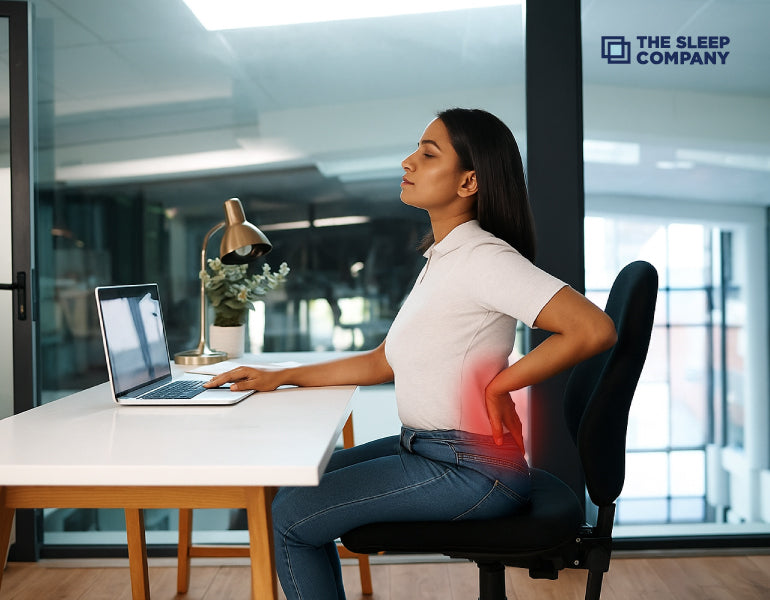My Cart

The Best Posture For Sitting At A Desk All Day

Spending your time at a desk all day long is not easy. Your neck and back feel the strain, whether you are hard at work or taking things slow. But that's not all. Even when you start your day with your back straight, you inevitably find yourself hunched over in an hour or two. We have all been there!
Now, you already know it's not good for the back, especially in the long run. You end up with pain and stiffness that makes your job harder. So, the question here is, how can you fix it? Well, we have got you covered. Ahead, we unpack everything you must know about the best sitting posture. Let's dive in!
What Is a Good Sitting Posture and Why Does It Matter?
The best posture for sitting means aligning your body so your spine remains at its natural curve. To put it simply, good sitting posture is sitting or standing in a way where your back is straight, your shoulders remain relaxed, and your head stays in line with your spine without compromising on comfort. But why does it matter? Is being hunched over so bad?
Yes! Good sitting posture is incredibly important, and here's why:
Reason I: The best posture for sitting reduces strain and pain, which, of course, is the most important reason of all. When you maintain proper alignment, you lower pressure on intervertebral discs. This can reduce strain and stiffness vastly.
Reason II: Did you know? A neutral sitting posture engages the core and muscles. So, your balance and strength improve over time.
Reason III: When you sit or stand with your chest open and back straight, your lungs and stomach have more space to work. So, you are able to breathe deeply, and your stomach digests food better. So, bye-bye bloating.
Reason IV: When you sit up straight, it positively affects your work. First, you showcase a confident front. Second, you remain focused.
Reason V: Slouching or sitting badly for a long time puts extra pressure on your joints and muscles. Over time, this can cause pain, stiffness, poor flexibility, and problems like varicose veins or even heart issues from sitting too much. Good sitting posture helps keep your body in better shape as you age.
The Best Posture For Sitting: A Step-by-Step Breakdown
This is the best sitting posture for sitting at a desk all day long.
- Keep both feet resting flat. Here, you can always use a footrest if your feet don't reach.
- Your knees should be at a 90-degree angle. Basically, they should be level with or slightly lower than your hips.
- Sit all the way back so your lower back touches the chair.
- Use back support. Make sure your lower back is well supported. If needed, use a small cushion or lumbar support.
- Always sit upright and not slouched. However, keep your shoulders relaxed. Let them drop naturally.
- You can place your elbows at your sides by bending them at a 90-degree angle.
- Your arms should rest comfortably on the desk or armrests.
- Now, your head should be in line with your spine. And, your ears should be right above your shoulders.
- Make sure your screen is at eye level, in a way that your computer screen is directly in front of you.
- Lastly, use a perfect chair and take breaks every hour.
Common Mistakes To Avoid When Sitting At A Desk
Here are a few common mistakes you must avoid to ensure you maintain a good sitting posture while remaining utterly comfortable throughout the work hours.
- Avoid slouching or leaning forward as it strains your neck and back.
- Crossing legs for long periods should be a no-no as it can affect blood flow and throw off your bodys balance.
- Don't crane your neck toward the screen, as it can lead to neck and shoulder pain.
- Avoid sitting perched on the edge of the seat, as it prevents you from enjoying proper back support.
- Using a laptop without an external keyboard or mouse forces awkward arm and neck positions. So, use accessories to improve alignment.
Ergonomic Tips to Support Better Sitting Postures

Now that you are familiar with the best sitting posture, lets look at a few ergonomic tips to help you further.
Invest In A Good Ergonomic Chair Or Lumbar Support
Apart from ensuring you opt for the best posture for sitting, make sure you invest in a quality ergonomic chair. This not only keeps you super comfy but also supports the natural curve of your spine. Then, look for adjustable features and built-in lumbar support. For instance, The Sleep Company's UNO Ergonomic Office Chair comes with a firm adjustable lumbar for lower back comfort.
Use A Sit-Stand Desk Or Change Positions Periodically
Have you had days when you have been sitting for so long that it causes a sense of fatigue? Well, it can also lead to stiffness and pain, and can disrupt your productivity. Here, a sit-stand desk can be great as it lets you switch between sitting and standing, which boosts circulation and energy. The Adjustable Desk by The Sleep Company can be a great choice. With smart controls and a stable build, it is perfect to help reset your posture periodically.
Add A Footrest If Your Feet Dont Reach The Floor
Dangling feet can strain your legs and lower back. That's why a footrest helps you keep your feet flat and knees at the right angle. You can also opt for an ergonomic chair with a footrest. For instance, The Sleep Company's Ultron Premium Ergonomic Office Chair comes with a cushioned footrest slider for absolute comfort.
Consider A Monitor Riser Or Laptop Stand
Looking down at a screen for hours can cause neck and shoulder pain. So, you can use a monitor riser or laptop stand. This way, you ensure the screen is at your eye level and can maintain proper neck position.
Microbreaks and Movement
Lastly, apart from the best posture for sitting, make sure you move to prevent aches and pains while improving productivity.
Importance of standing and stretching every 3060 minutes
Even if you opt for the best posture for sitting, you need a break every hour. It doesn't have to be long, just a couple of minutes. You can simply stand and stretch, and it boosts your blood flow, reduces tension, and improves focus.
Quick Exercises to Try

Here are a few quick exercises you must try during your quick breaks.
- Neck rolls: Here, gently roll your head side to side for a couple of minutes.
- Shoulder shrugs: Slowly lift and release your shoulders, but don't be too stiff.
- Seated leg lifts: In this exercise, raise your legs one at a time to activate the muscles.
- Wrist circles and finger stretches: This exercise is especially great if you type a lot.
- Wall push-ups or calf raises: This is a perfect exercise to get your blood moving.
Apps or Timers to Remind you to Move
When you have strict deadlines to meet, it is possible that you lose track of time. But you don't want to invite aches and stiffness that can hamper productivity. So, simply set a timer on your phone or computer. Or you can download apps to help you out. These gentle nudges keep you accountable and help build healthy habits.
Conclusion
Remember, good posture is not all about sitting up straight. Instead, its about being relaxed while keeping your body well-aligned and supported. This is important in the long run as it can otherwise adversely affect your health and your productivity. However, apart from your sitting posture, it is also important that you create a workspace that aids your comfort.
This is where The Sleep Company comes into the picture. Our ergonomic office chairs, adjustable desks, ortho cushions, etc., are designed to reduce pain and help you remain more focused every day.
What are you waiting for? Choose our perfect ergonomic tool today, so you can work smarter, feel better, and move freely.
FAQs
To maintain good posture, sit straight, keep your shoulders relaxed, and feet flat. Also, make sure you take regular breaks for a couple of minutes to stand and stretch.
When you have to remain seated for long hours, make sure you sit fully back in the chair with your feet flat and shoulders relaxed. Also, avoid slouching.
Don't worry, while sitting all day can be unhealthy, taking necessary measures can help you out. Make sure you take a break for a few minutes every hour to avoid poor circulation, muscle weakness, and even an increased risk of heart disease.
Practice sitting and standing tall with your shoulders back and core engaged. You can also use ergonomic furniture, stretch regularly, and build strength in your back and core to support proper alignment.























![How to Choose the Right Office Chair? [2025 Expert Guide]](http://thesleepcompany.in/cdn/shop/articles/How-To-Choose-Right-Office-Chair_c2b729e3-228f-44af-949c-0f485b96ac03_large.jpg?v=1757653287)





















